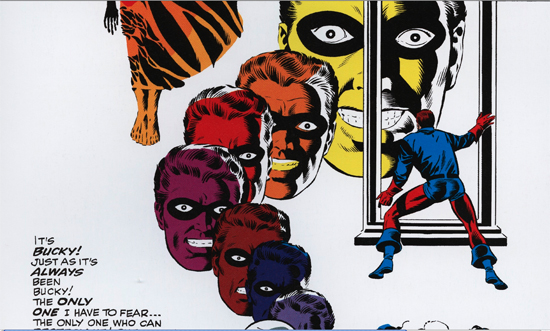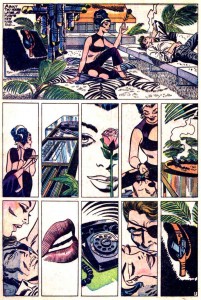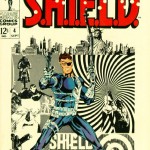
December 23, 2011, by Stephen Mumford
Steranko
I have an article in Times Higher Education magazine this week on superpowers and comic books. I mention there the work of Jim Steranko. My view is that Steranko played a key role in the evolution of the comic book from throwaway pulp to high art.
Comics had a very formulaic look all the way into the mid-60s based on nine or six regular panels per page. Jack Kirby had experimented with single-page visual feasts involving photography but it wasn’t until Steranko that the rules really started to be broken.
Steranko began in comics by inking over Kirby’s pencils on a strip called Nick Fury, Agent of SHIELD in the title Strange Takes. He eventually took over full artistic responsibilities, including colouring, and it was then that his imagination was set loose. We were treated to some stunning visuals, including frequent touches of Op Art, surrealism, experimental panel layouts, full page panels, two-page spreads and even a four-page spread for which you had to buy two copies of the book and lay them end-to-end.
 As well as such visual impact, however, Steranko was still strong in the basic craft of storytelling through panels. A perfect example was one almost-silent page depicting an unfolding seduction. Editor Stan Lee insisted that the final panel was too explicit. Steranko had the last laugh, however, replacing it with a gun in a holster, the obvious symbolism of which escaped Lee.
As well as such visual impact, however, Steranko was still strong in the basic craft of storytelling through panels. A perfect example was one almost-silent page depicting an unfolding seduction. Editor Stan Lee insisted that the final panel was too explicit. Steranko had the last laugh, however, replacing it with a gun in a holster, the obvious symbolism of which escaped Lee.
Steranko became a victim of his own success, however. He took over writing as well as artistic responsibilities for Nick Fury, which was given its own full-length monthly title. Steranko couldn’t meet the deadlines, often leading to Marvel having to find last-minute replacements. He produced a handful of issues of X-Men and Captain America and had a few other stories in the pipeline but artistic differences with Lee saw him leave the world of comic book illustration and move into publishing. It was thus a very short career but Steranko had already raised the artistic bar for those who would follow. They would all see themselves as artists rather than mere illustrators and the comic book format had entered a new phase.
often leading to Marvel having to find last-minute replacements. He produced a handful of issues of X-Men and Captain America and had a few other stories in the pipeline but artistic differences with Lee saw him leave the world of comic book illustration and move into publishing. It was thus a very short career but Steranko had already raised the artistic bar for those who would follow. They would all see themselves as artists rather than mere illustrators and the comic book format had entered a new phase.
Steranko in Wikipedia: http://en.wikipedia.org/wiki/Jim_Steranko
My article in Times Higher Education on the history of comics: http://www.timeshighereducation.co.uk/story.asp?sectioncode=26&storycode=418481&c=2

Great post, hope you are doing well, hey the links below will download STERANKO screen-savers/wallpapers for your computer… they’re for Tony Robertson’s fan-site (I’m the designer) also below are other links containing many good features on him as well… all the best to you.
SCREENSAVERS:
http://www.thedrawingsofsteranko.com/wallpaper/screensaver_hm.HTML
http://www.thedrawingsofsteranko.com/
RED TIDE Feature:
http://www.thedrawingsofsteranko.com/RED_TIDE/chndlr_hmpg_.html
http://www.thedrawingsofsteranko.com/RED_TIDE/chndlr_gal.html
20 page revised RED TIDE feature in DH Presents:
If link below doesn’t open, cut and paste into your browser.
http://www.johngandour.com/john_g/RED_TIDE.zip
********************************************
HOMAGES (with Steranko commentary):
http://www.thedrawingsofsteranko.com/Ster_hmgs/ster_homages_pg.html